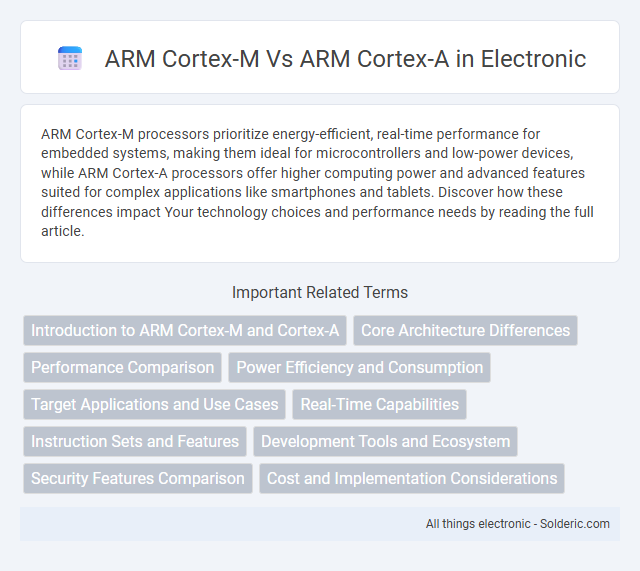ARM Cortex-M processors prioritize energy-efficient, real-time performance for embedded systems, making them ideal for microcontrollers and low-power devices, while ARM Cortex-A processors offer higher computing power and advanced features suited for complex applications like smartphones and tablets. Discover how these differences impact Your technology choices and performance needs by reading the full article.
Comparison Table
| Feature | ARM Cortex-M | ARM Cortex-A |
|---|---|---|
| Target Application | Microcontrollers, embedded systems | High-performance applications, smartphones, tablets |
| CPU Architecture | ARMv7-M, ARMv8-M | ARMv7-A, ARMv8-A |
| Performance | Low to Medium (up to 1 GHz) | High (up to several GHz) |
| Power Consumption | Low power optimized | Higher power, performance focused |
| Instruction Set | Thumb, Thumb-2 | ARM, Thumb, Thumb-2 |
| MMU | Typically no (uses MPU) | Yes, full Memory Management Unit |
| Use Case Examples | IoT devices, automotive control, wearables | Smartphones, laptops, multimedia devices |
| Operating Systems | RTOS, bare-metal | Linux, Android, Windows |
| Complexity | Simple, deterministic | Complex, multitasking capable |
Introduction to ARM Cortex-M and Cortex-A
ARM Cortex-M processors are designed for low-power, cost-sensitive embedded applications, offering efficient performance for microcontroller units (MCUs) in IoT devices, wearables, and automotive systems. ARM Cortex-A processors deliver high-performance computing suitable for complex operating systems like Linux and Android, commonly used in smartphones, tablets, and advanced consumer electronics. Understanding the distinct purposes of Cortex-M for real-time, deterministic tasks and Cortex-A for rich operating environments helps you select the right architecture for your project needs.
Core Architecture Differences
ARM Cortex-M cores feature a simplified, deterministic pipeline designed for real-time, low-power embedded applications with a focus on interrupt handling and low-latency execution. ARM Cortex-A cores incorporate complex, out-of-order execution pipelines with advanced features like branch prediction and multi-level caches, enabling high-performance computing for operating systems and multimedia processing. Your choice between these cores depends on whether you prioritize real-time responsiveness and energy efficiency or computational power and sophisticated processing capabilities.
Performance Comparison
ARM Cortex-A processors deliver higher performance due to their advanced out-of-order execution and higher clock speeds, making them ideal for complex applications like smartphones and tablets. ARM Cortex-M cores prioritize energy efficiency and real-time responsiveness with a simpler, deterministic architecture, suitable for embedded systems and IoT devices. Your choice depends on whether raw processing power or low power consumption with real-time capabilities is more critical for your project.
Power Efficiency and Consumption
ARM Cortex-M processors are designed for ultra low power consumption, making them ideal for battery-powered and energy-sensitive applications such as IoT devices and wearables. In contrast, ARM Cortex-A processors offer higher performance but consume significantly more power, targeting smartphones, tablets, and complex computing systems where energy efficiency is balanced with processing power. Your choice between Cortex-M and Cortex-A should consider the application's power efficiency requirements versus processing demands to optimize overall energy consumption.
Target Applications and Use Cases
ARM Cortex-M processors are optimized for low-power, cost-sensitive embedded applications such as microcontrollers in IoT devices, automotive controls, and industrial automation systems. ARM Cortex-A processors target high-performance applications including smartphones, tablets, and advanced consumer electronics requiring robust operating systems and rich multimedia capabilities. Your choice between Cortex-M and Cortex-A depends on whether you need efficient real-time control or complex processing power.
Real-Time Capabilities
ARM Cortex-M processors offer deterministic real-time capabilities with low interrupt latency and predictable execution times, making them ideal for embedded control applications requiring precise timing. In contrast, ARM Cortex-A processors prioritize higher performance with complex out-of-order execution and multitasking support, which can introduce latency variability, limiting their suitability for strict real-time tasks. Consequently, Cortex-M cores are preferred in real-time systems such as automotive control and industrial automation, while Cortex-A cores target applications demanding rich operating systems and user interfaces.
Instruction Sets and Features
ARM Cortex-M processors utilize the ARMv7-M and ARMv8-M instruction sets, optimized for low power consumption and real-time applications with features like Thumb-2 for efficient 16/32-bit mixed instructions and deterministic interrupt handling. ARM Cortex-A processors employ the ARMv7-A and ARMv8-A instruction sets, supporting advanced features such as out-of-order execution, SIMD (NEON), and virtualization to deliver high performance for complex operating systems and multimedia tasks. Understanding the distinct instruction sets and features helps you choose the right processor architecture tailored to embedded control or high-performance computing needs.
Development Tools and Ecosystem
ARM Cortex-M processors benefit from a robust ecosystem featuring lightweight IDEs like Keil MDK and STM32CubeIDE, optimized for real-time embedded applications with extensive middleware and RTOS support. ARM Cortex-A processors leverage powerful development tools such as ARM DS-5 and Linaro toolchains, enabling advanced debugging and profiling for complex operating systems like Linux and Android. The robust ecosystems around both cores provide scalable development environments but cater distinctly to embedded microcontroller applications versus high-performance applications.
Security Features Comparison
ARM Cortex-M processors integrate TrustZone for Armv8-M, providing robust hardware-enforced isolation between secure and non-secure code, ideal for IoT and embedded applications requiring real-time security. ARM Cortex-A processors feature full TrustZone technology with advanced Secure World execution, alongside virtualization-based security extensions and hardware-assisted encryption engines, suited for complex OS environments. The Cortex-A series supports richer security frameworks including ARM Security Extensions for kernel-level protection, whereas Cortex-M emphasizes minimal trusted computing base for lightweight devices.
Cost and Implementation Considerations
ARM Cortex-M processors offer lower cost and simpler implementation, making them ideal for cost-sensitive embedded applications with limited resources. Cortex-A processors, designed for high-performance tasks, require more expensive development tools, power management, and complex operating systems, increasing overall cost and implementation complexity. Your choice affects development budgets and system architecture due to differences in processing power and integration requirements.
ARM Cortex-M vs ARM Cortex-A Infographic

 solderic.com
solderic.com